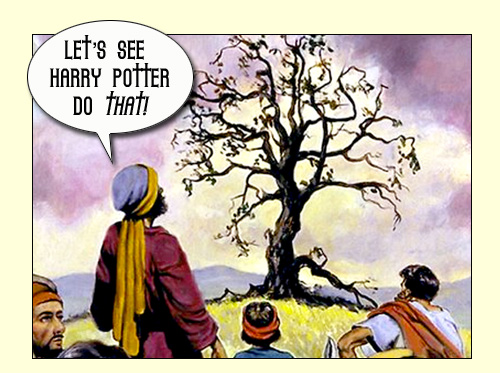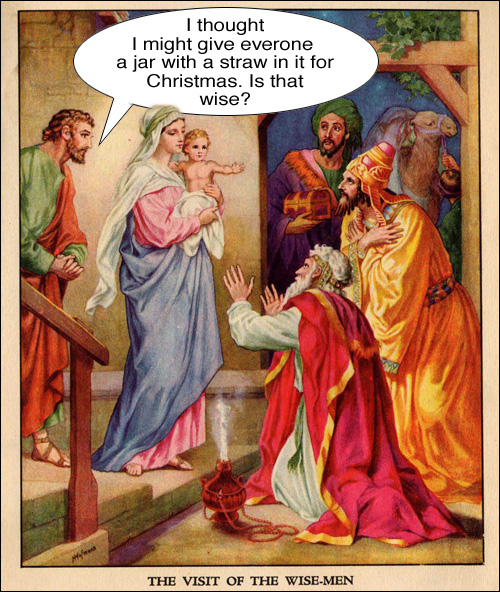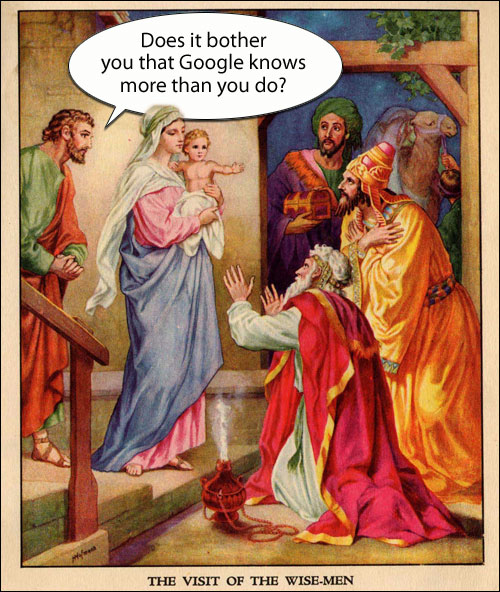Tetherd Cow Ahead Presents: The Baffling Bible
Episode #5: Jesus and the Fig Tree

When I was a kid in Sunday School, I learned lots about the life of Jesus. I knew the stories of the Sermon on the Mount, the casting out of demons into swine, the miracle of the loaves & fishes, the overturning of the moneylenders’ tables in the tabernacle and many other colourful yarns that have turned out to have about as much relevance to my adult life as they did to my ten-year-old self.
One baffling tale that doesn’t usually get much of an airing when the life of Our Lord is being recounted, though, is the story of Jesus and the Fig Tree. It certainly didn’t make it into my Bible class back in the day – I think it’s just possible that’s because a ten-year-old might’ve empathized with it all too well.
To set the the scene: Jesus has returned from his 40 days and nights in the desert where he has had a lengthy hobnob with God, and is traipsing across the countryside accumulating crowds ((We should take mentions of ‘crowds’ in the Bible with a grain of salt. That part of the world was not especially densely populated at that time, and I suspect that if you got a toothless man and his wife and their goat to come out and look at you, that probably counted as a ‘crowd’. Especially in the eyes of someone spinning a yarn to beat up some PR, as Matt and Mark unquestionably are.)) of the faithful and assembling the cabal of chaps who would end up as his apostles. This is the Jesus of Matthew and Mark. This is the Jesus we all know and love from the comic books; he has just appeared to his followers (and Matthew & Mark’s readers) in dazzling white raiment which of course proves he is not just some guy like all the other common-garden-variety Messiahs who were touring the land at the time. In addition, he takes every opportunity to voice noble (if mostly obvious and occasionally curious) moral advice, and he performs miracles. Lots of them. ((I feel I have to point out that, in the light of the way we are familiar with ‘healings’ & clairvoyance and visions of the Virgin and other contemporary ‘miracles’, you don’t have to try too hard to come up with fairly reasonable non-supernatural explanations for all Jesus’ marvellous conjurations. And given nearly 20 centuries of undoubted ’embroidery’, well…))
The Story of the Fig Tree is one such miracle. We’ll take up the tale with Jesus waking up one morning after having spent the night in the countryside outside Jerusalem (somewhere around here I figure). Over to Matthew to relate the tale in his compelling literary style:
Now in the morning as he returned into the city, he hungered.
And when he saw a fig tree in the way, he came to it, and found nothing thereon, but leaves only, and said unto it, Let no fruit grow on thee henceforward for ever. And presently the fig tree withered away.
And when the disciples saw it, they marvelled, saying, How soon is the fig tree withered away!
~(Matthew 21:19)
In other words, because Jesus was hungry and there were no figs, he threw a tantrum and did the supernatural equivalent of punching his fist through the wall: he put a curse on the tree. Kapow! Take THAT you stupid tree! I’ll teach you not to have figs out of season!
Now religious scholars are quick to put forward all kinds of explanations for this decidedly tetchy Saviour behaviour. It’s certainly not fashionable these days to have Jesus to appear to petulantly invoke his super powers out of spite, so most modern Christian scholars interpret the story of Jesus and the Fig Tree as some kind of metaphorical statement about the condition and the predicted eventual fate of the Jewish nation.
But I want you to pause and reflect on that for a moment. None of Jesus’ other miracles get the ‘allegory’ explanation. If Jesus does a really cool thing – like healing a blind man, say, or walking across a lake – that’s not a metaphor. That’s a myrrh-soaked, gold-plated, frankinsence-doused, cross-my-heart-and-hope-to-die-and-never-be-resurrected MIRACLE! But when Our Lord chucks a tanty and fries a fig tree, well then, that must be symbolic…
That’s all well and good, and I might even buy it except for one thing: both Matthew and Mark independently make the effort to point out that Jesus was hungry. This tiny detail makes nonsense of the fall-of-the-Jewish-nation explanation. How does that high-falutin’ symbolism have anything to do with Jesus not getting breakfast? Plus, it just gives the whole story a ring of truth – I mean, we’ve all been there, right?
No, Faithful Acowlytes, I believe that the most reasonable hypothesis for this story is that Jesus just got out of bed on the wrong side and took his grumpiness out on the first thing he saw (and I offer this as scientific endorsement of my assertion). Luckily it was just a tree – his dad had something of a tendency to take his pique out on entire cities.
Or maybe, just maybe, the Westboro Baptist Church has had it right all along, only their bibles have a small typographical error…











